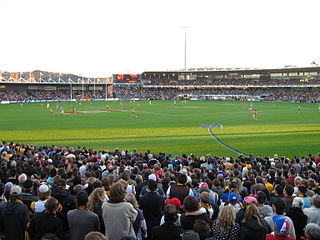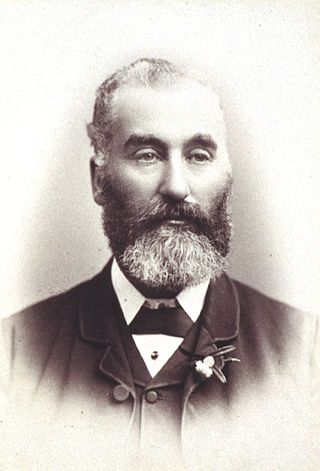
Hobart is the capital and most populous city of the island state of Tasmania, Australia. Home to almost half of all Tasmanians, it is the southernmost and least-populated Australian state capital city, and second-smallest if territories are taken into account, before Darwin, Northern Territory. Hobart is located in Tasmania's south-east on the estuary of the River Derwent, making it the most southern of Australia's capital cities. Its skyline is dominated by the 1,271-metre (4,170 ft) kunanyi/Mount Wellington, and its harbour forms the second-deepest natural port in the world, with much of the city's waterfront consisting of reclaimed land. The metropolitan area is often referred to as Greater Hobart, to differentiate it from the City of Hobart, one of the seven local government areas that cover the city. It has a mild maritime climate.
The history of Tasmania begins at the end of the Last Glacial Period when it is believed that the island was joined to the Australian mainland. Little is known of the human history of the island until the British colonisation of Tasmania in the 19th century.

Clarence City Council is a local government body in Tasmania, and one of the five municipalities that constitutes the Greater Hobart Area. The Clarence local government area has a population of 61,531, covering the eastern shore of the Derwent River from Otago to the South Arm Peninsula and the smaller localities of Cambridge, Richmond, and Seven Mile Beach.

Bellerive Oval is a cricket and an Australian rules football ground located in Bellerive, a suburb on the eastern shore of Hobart, Australia. Holding 20,000 people, it is the largest capacity stadium in Tasmania. It is the only venue in Tasmania which hosts international cricket matches.

The Tasmania men's cricket team, nicknamed the Tigers, represents the Australian state of Tasmania in cricket. They compete annually in the Australian domestic senior men's cricket season, which consists of the first-class Sheffield Shield and the limited overs Matador BBQs One-Day Cup.

Lindisfarne is a suburb of Hobart's Eastern Shore, located approximately 6 kilometres from the City Centre and is part of the municipal City of Clarence.
Montagu Bay is a suburb of Hobart, Tasmania, located in the City of Clarence on the eastern shore of the Derwent River, about four kilometres from the city centre of greater Hobart. It is a small primarily residential suburb located between Rosny, Rose Bay and Lindisfarne and is centred on a small bay of the same name, formerly known as Smelting Works Bay. The bay has a boat ramp and jetty, and is frequently filled with yachts and other vessels at anchor.

Geilston Bay is a largely residential suburb of Hobart between Risdon Vale, Shag Bay, and Lindisfarne, in the City of Clarence located on the Eastern Shore of the Derwent River, taking its name from an inlet of that river of the same name. The inlet and locality were sometimes known by the alternative name "Limekiln Bay" on account of lime kilns which operated there between approximately the 1830s and the 1920s, the remains of which remained visible for some decades thereafter; another early name for the Bay was "James's Bay". The present suburb name derives from an early land holding "Geils Town" in the region purchased by Andrew Geils, Commandant of Van Diemen's Land (Tasmania) for a brief period in 1812-1813, who subsequently left his Australian holdings behind when he moved back to Scotland.

Australian rules football in Tasmania, has been played since the late 1860s and draws the largest audience for a football code in the state.
Cornelian Bay is a small suburb in Hobart, Tasmania, Australia. It lies just north of the urban parkland, the Queens Domain. The bay itself is a safe anchorage for yacht owners.
The TCA Ground, or Tasmanian Cricket Association Ground, is one of two first-class standard cricket grounds in Hobart, Tasmania. It is located on the Queens Domain less than one kilometre from the CBD.

KGV Oval is the home headquarters of the Glenorchy football and cricket clubs, as well as the Southern Football League.
Cricket Tasmania Premier League, or Tasmanian Premier Cricket, refers to the hierarchically graded cricket competitions played in Tasmania, Australia. The Cricket Tasmania Premier League comes under the administration of Cricket Tasmania.

The Colony of Tasmania was a British colony that existed on the island of Tasmania from 1856 until 1901, when it federated together with the five other Australian colonies to form the Commonwealth of Australia. The possibility of the colony was established when the Parliament of the United Kingdom passed the Australian Constitutions Act in 1850, granting the right of legislative power to each of the six Australian colonies. The Legislative Council of Van Diemen's Land drafted a new constitution which they passed in 1854, and it was given royal assent by Queen Victoria in 1855. Later in that year the Privy Council approved the colony changing its name from "Van Diemen's Land" to "Tasmania", and in 1856, the newly elected bicameral parliament of Tasmania sat for the first time, establishing Tasmania as a self-governing colony of the British Empire. Tasmania was often referred to as one of the "most British" colonies of the Empire.

The Tasmania Women cricket team, also known as Tasmanian Tigers and previously Tasmanian Roar, is the women's representative cricket team for the Australian State of Tasmania. They play their home games at Blundstone Arena, Hobart. They compete in the Women's National Cricket League (WNCL), the premier 50-over women's cricket tournament in Australia. They previously played in the now-defunct Australian Women's Twenty20 Cup and Australian Women's Cricket Championships.

Sir John George Davies, generally known as (Sir) George Davies, was a Tasmanian politician, newspaper proprietor and first-class cricketer.

Boyer Oval is the home headquarters of the New Norfolk District Football Club and the Molesworth Cricket Club. The ground is a former Tasmanian Football League venue, being the host venue of 825 official TFL matches for New Norfolk in TFL football from 1947 to 1999 and from 2000 it became a venue for SFL football when New Norfolk were demoted from the Statewide League. It is located on First Avenue and has a back entrance on Back River Road at New Norfolk, 38 kilometres north-west of the Hobart CBD.
William Holden Walker was an English-born Australian cricketer. As captain of the Tasmanian cricket team, Walker was one of Tasmania's leading cricketers of his time. Known for his all-round capabilities, he was a right-handed batsman and an underarm bowler, as well as keeping wicket. Walker was named in the Cricket Tasmania Premier League's "Team of the Decade" for the decade spanning 1866–67 to 1875–76.
On 11 and 12 February 1851, teams from Van Diemen's Land and Port Phillip District played the first cricket match between two Australian colonies, recognised in later years as the inaugural first-class cricket match in Australia. It took place at the Launceston Racecourse, known now as the NTCA Ground, in Tasmania. The match was incorporated into celebrations marking the separation of the Port Phillip District from New South Wales in 1851 as the colony of Victoria.
Frederick Chancellor was an Australian cricketer. He played eleven first-class matches for Tasmania between 1902 and 1912.










